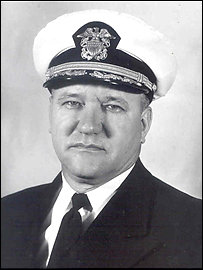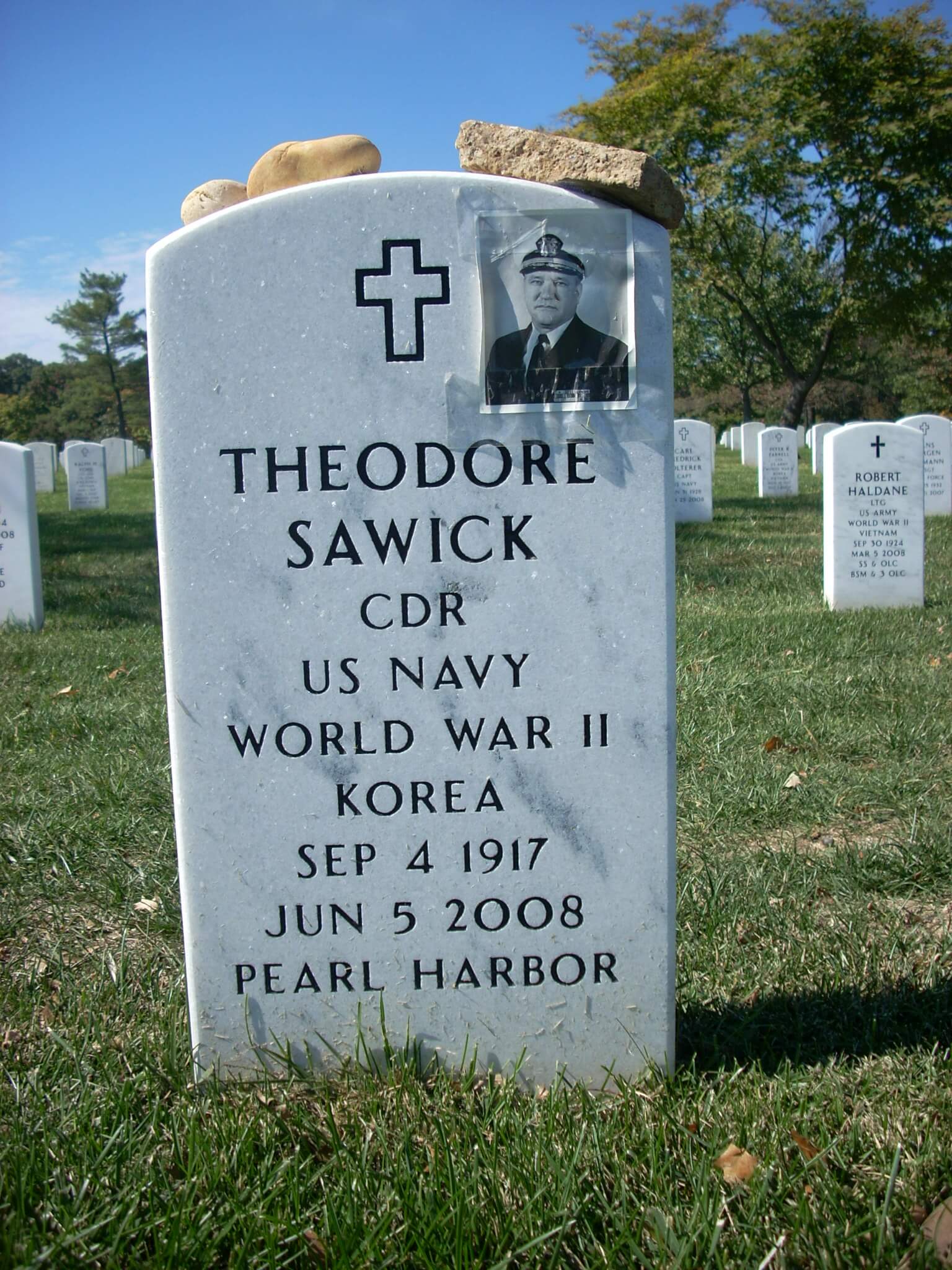Theodore Sawick; Pearl Harbor Survivor
By Yvonne Shinhoster Lamb
Courtesy of The Washington Post
Saturday, June 28, 2008
Theodore Sawick, 90, who as young sailor survived the attack on Pearl Harbor and went on to serve 32 years in the Navy before retiring as a Commander, died of septic shock June 5, 2009, at Inova Fairfax Hospital. He lived in Annandale, Virginia.
Since his retirement from the Navy and later from the U.S. Maritime Administration, Commander Sawick devoted himself to promoting accurate, firsthand accounts of the December 7, 1941, air raid by Japan.He served as president of the Northern Virginia chapter of the Pearl Harbor Survivors Association, spoke to local schoolchildren and made a video for the television station at Marine Corps base at Quantico. As a panelist on a C-SPAN broadcast, he disputed the accuracy of the 2001 movie “Pearl Harbor.”
Sitting in his home during the videotaping, Commander Sawick recounted the fast-paced drama that unfolded around him during the 1941 attack. He had joined the Navy in 1935 and spent the months before the attack practicing anti-torpedo boat tactics in Hawaiian waters before preparing to transfer to the Philippines.
Early December 7, he was a crew member of the motor torpedo boat PT-42 and was on board the oil tanker Ramapo, which was moored at the Navy Yard in Pearl Harbor. Six torpedo boats had been loaded on to the tanker the night before, and two others were being secured about 6:30 a.m. when someone called down from the bridge saying that the Army was running aircraft bombing maneuvers at Hickam Field and at Ford Island, Cmdr. Sawick recalled.
Within an hour, Japanese aircraft began approaching the island of Oahu from the northeast. “It took about 25 to 30 minutes before they arrived,” he recalled, and then three or four minutes before the first bombs landed on Hickam Field and Ford Island.
“About five or six minutes after that, Japanese torpedo planes came in from the north side and dropped their torpedoes on the row of battleships . . . and four or five minutes after the first four torpedoes hit, the battleship Oklahoma suddenly started to capsize.”
Commander Sawick said he was stunned when he saw the Oklahoma hit and the battleship Arizona blown up. “It was the most unbelievable sight you ever wanted to witness,” he said. Flames and smoke soon obscured the battleships.
As the attack continued for up to 30 minutes, the Ramapo was ordered out of the attack zone, but not before a bomb landed on its stern. Following orders to abandon ship, crew members jumped overboard and starting running away from the dock as Japanese planes strafed the area.
After a pause in the attack, the sailors returned to the Ramapo, which survived the attack, and the tanker pulled out of the dock. The tanker passed by the row of heavily damaged battleships and through waters contaminated with oil. Flames rose in parts of the water, Commander Sawick recalled, and sailors yelled for help.
“It was a sight,” he said, his voice cracking. “When I think about it now, I still get choked up trying to talk about it.”
Commander Sawick was born in East Lyme, Connecticut, and enlisted in the Navy after graduating from high school in 1937. He started the transport Chaumont and spent two years aboard the destroyer tender Dobbin before beginning a seven-year tour of duty in 1940 on PT boats in the Pacific.
Over the next four years, he saw action at the Battle of Midway and the Battle of the Solomons as well as campaigns at New Guinea, Philippines and Borneo.
After the war, he served as an engineering officer on the destroyer Charles R. Ware and had special duty in 1949 as a member of the U.N. staff headed by Ralph Bunche, the acting U.N. mediator on Palestine, during the signing of an armistice agreement between the new country of Israel and the surrounding Arab countries.
From 1951 to 1962, Commander Sawick’s tours included commanding the minesweeper Pigeon, serving as executive officer of the destroyer Laffey and as operations officer of the destroyer Norfolk.
In February 1962, he was engineering officer on the aircraft carrier Randolph when it picked up astronaut John H. Glenn Jr. after his historic orbit of the Earth in Friendship 7. A month later, he returned to the Laffey as commanding officer.
Commander Sawick retired in 1969 as NATO operations and training officer for staff of the Commander-in-Chief of the U.S. Atlantic Fleet.
He joined the Maritime Administration as U.S. and NATO military planning officer. He had primary responsibility for dealing with the wartime relations between merchant shipping and U.S. and NATO naval authorities.
Commander Sawick, recognized as a leading expert in his field, was largely responsible for the form and content of civil shipping in the NATO naval control of shipping manual.
In 1979, Commander Sawick retired from the Maritime Adminstration, which awarded him its highest honor, the Bronze Medal Award.
Survivors include his wife of 62 years, Katherine Sawick of Annandale; two children, Kerry Sawick of Flower Mound, Tex., and Neal Sawick of Machias, Maine; and two grandchildren.
SAWICK, THEODORE
- CDR US NAVY
- WORLD WAR II, KOREA
- DATE OF BIRTH: 09/04/1917
- DATE OF DEATH: 06/05/2008
- BURIED AT: SECTION 59 SITE 3326
- ARLINGTON NATIONAL CEMETERY
Michael Robert Patterson was born in Arlington and is the son of a former officer of the US Army. So it was no wonder that sooner or later his interests drew him to American history and especially to American military history. Many of his articles can be found on renowned portals like the New York Times, Washingtonpost or Wikipedia.
Reviewed by: Michael Howard


